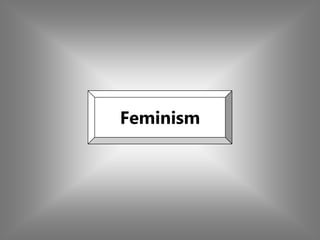
feminism.ppt
- 1. Feminism
- 2. Politicization of the sex-class identity Gender Oppression
- 4. 1800s Organized women’s rights movement 1830s- 1860s Movement to abolish slavery 1866 British MP John Stuart Mill petitioned the Parl. of the UK to grant suffrage to women 1921 Agnes Macphail 1st elected women MP 1920 Nat. League of Women Voters was created 1927 “Person’s Case” Senate appointments vote Universal Suffrage 1921 Federal Election 1929 JCPC reversed Supreme Courts decision
- 5. “No room at the top” only 3.5% of the world’s cabinet ministers were women women held no ministerial positions in 93 countries women were completely absent from the four highest levels in government in 50 countries: 5 in the group of Western European states; 16 in Asia and the Pacific; 8 in Latin America and the Caribbean; 21 in Africa women occupied less than 5% of the top positions in international organizations, including the UN and the European Community only a handful of women served as finance ministers (Bhutan, Finland, New Zealand, San Marino, Taiwan) In 1990:
- 6. Occupying highest offices of the state entering the polling booth Twice Prime Minister of Norway in the 1980s Gro Harlem Brundtland Indira Ghandi Prime Minister of India, 1966-77 Margaret Thatcher Prime Minister of Britain, 1979- 1990
- 7. “The first organized movement for women’s rights came form the movement to abolish slavery. ….. women’s rights organizers broke down many conventional barriers to the public participation of black people and women.” Rowbotham (1992) 1830s- 1860s Movement to Abolish Slavery
- 8. FINANCES ETHNICITY TRADITION Women’s lack of direct participation in top-level policy-making Political Participation Substantial growth for women? ORGANIZATION
- 10. PUBLIC SPHERE 1869 J.S. Mill Published On the Subjection of Women Pursuit of the franchise legal rights PRIVATE SPHERE
- 11. Private, political & economic sphere LEGAL RIGHTS ACCESS TO EDUCATION
- 12. Sacrifice? Who occupies the private sphere? ? PUBLIC SPHERE PRIVATE SPHERE
- 13. Betty Friedan The Feminine Mystique 1982 Charter of Rights and Freedoms 1960s Powerful emergence of Liberal Feminism 1970s and 1980s women entered universities and work force in increasing numbers “happy-housewife” myth 1988 - Supreme court confirmed abortion laws unconstitutional
- 15. KATE MILLET Gloria Steinem Naomi Wolf
- 16. Largest & most activist women’s mvt in the world 1992: outgoing Congress had only 6.4% women members incoming =11% in House, 7% in Senate. The electoral gap in the US has been shown to be critical to the success of the Democratic Party and to the nomination and election of some women candidates.
- 17. WILL WOMEN SHARING POLITICAL POWER EQUALLY WITH MEN CHANGE THE WAY WE LIVE? structural reforms
- 18. Studies indicate that a ‘critical mass’ of from 30- 35% inclusion of women in political leadership and gov’t is needed to affect public policies. Women should not settle for an in-name-only share of leadership…should use their positions to campaign for specific party commitments to the nomination, election and appt = # of men and women to national office, parls, cabs, courts, regional and st. legs, commissions, advisory groups. Parties and women’s orgs should seek out potential women candidates for political office and provide them with training in pol. and ldsp skills, funding and & Political Leadership
- 19. “Good Wives & Wise Mothers” TRADITION ? $
- 20. Biased Work force Deeply rooted Traditions Choices? ? April 10, 1946 Japan’s first “all person’s” election VOTE
- 21. Marxist Feminism Radical Reform Liberal Feminism
- 22. CYBER-FEMINISM